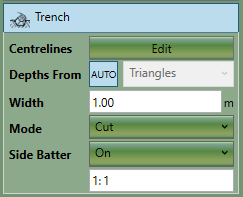The Trench element is used to define a linear path with a fixed width and defined depths.
This element is most commonly used for trenches.
The properties that are exposed for this element are summarised below.

|
-
Centrelines
The edit button will open the take-off window so that you can define the
centrelines which define the Trench.
Note: Depths are specified with positive values
- Depths From
This setting dictates from what surface the specified depths
are relative to. ‘Ground’ can be selected or you can select the ‘Previous Element’
if you want the depths to be relative to the surface when the previous element in
the calculation order is built. You can also select a named element. When the ‘Auto’
option is active ‘Depths From’ is dynamically set to the first absolute element
above it in the calculation order. If there aren’t any, it is set to ground. The
behaviour when ‘Auto’ is active is desirable in most circumstances.
-
Width
This is the width of the path.
-
Mode
This is used to specify if the element should have cut, fill or both. Most commonly cut and fill will be specified.
-
Side Batter
The Trench boundary is joined to the ground by side slopes. The side batter (set
as a ratio of vertical to horizontal) dictates the angle of these slopes. You can
set different side batter angles for side slopes that cut into the ground and for
those that fill into it. Turning side batter off will result in the Trench being
joined to the ground with vertical sides.
|

|
Estimates for linear structures like trenches, roads and causeways can be easily created. Learn how with the video:
Proposed Earthworks : The Path. Please note that for more complex roads,
we would recommend using the Feature Surface with varying level outlines and a centre line (defined by a break-line).
|

